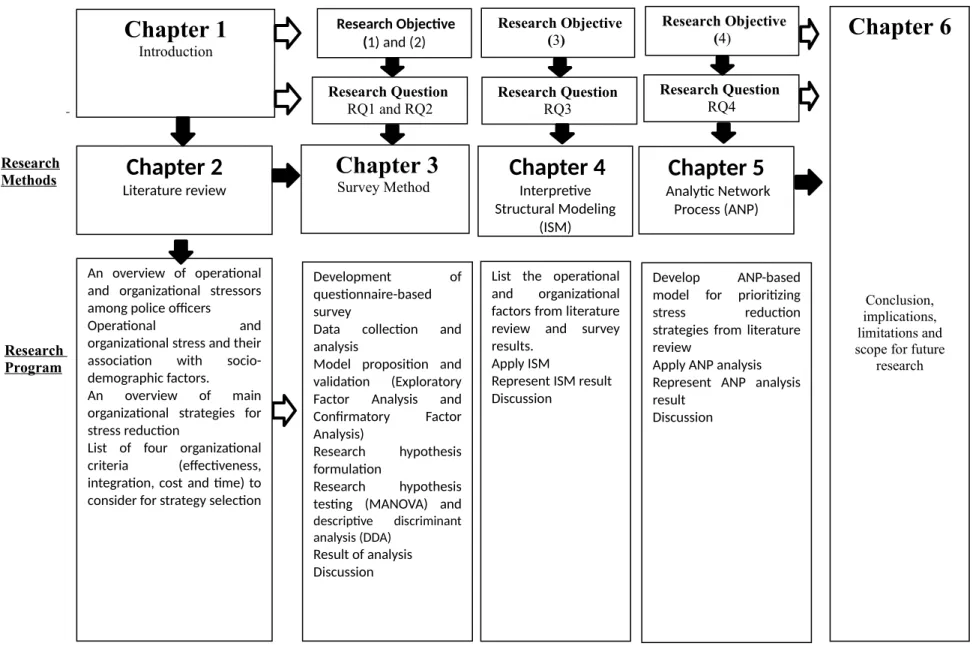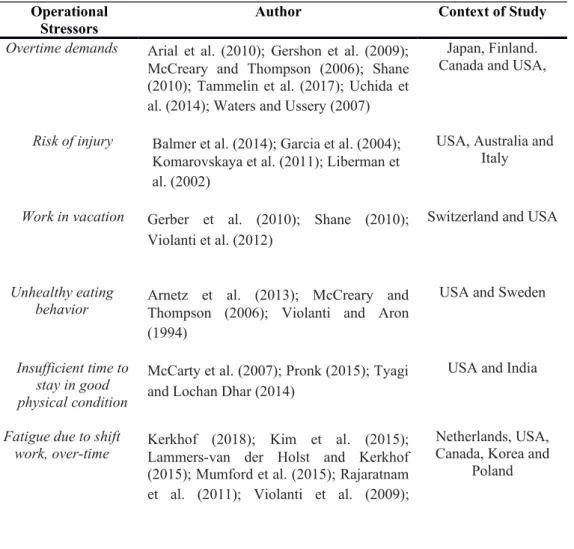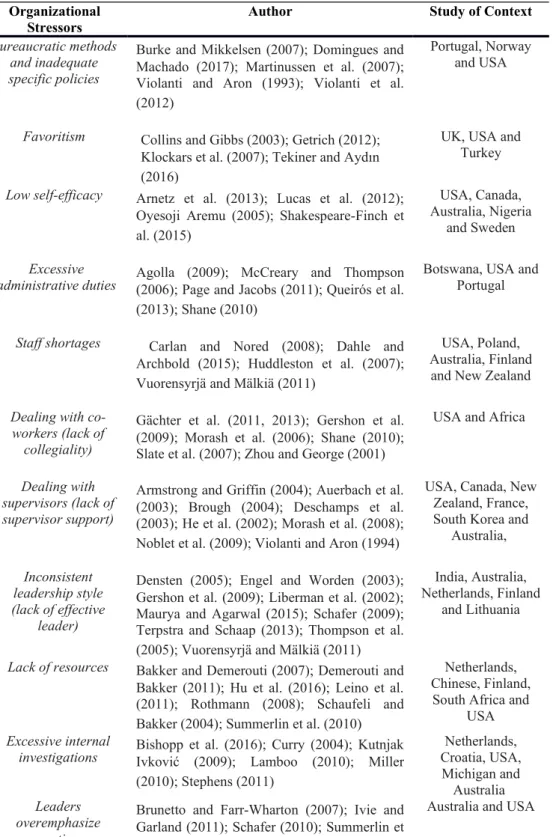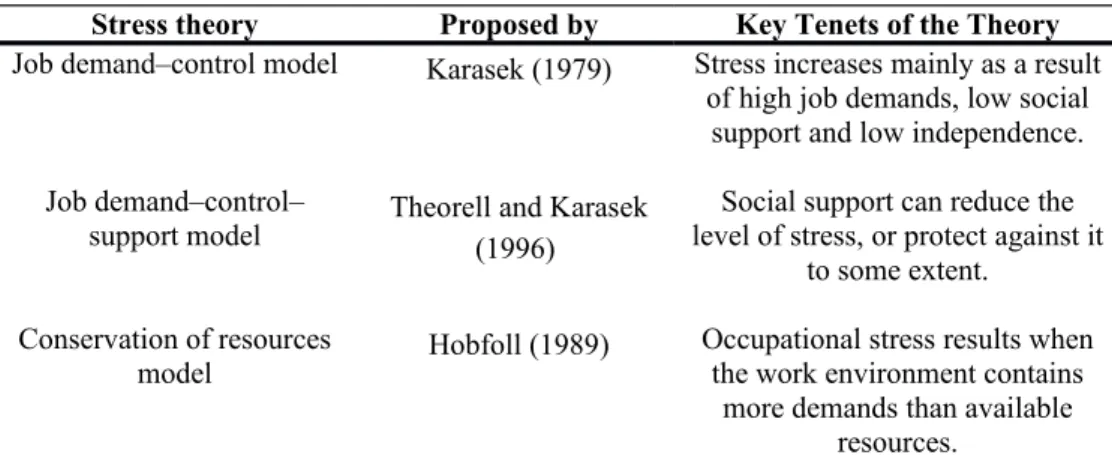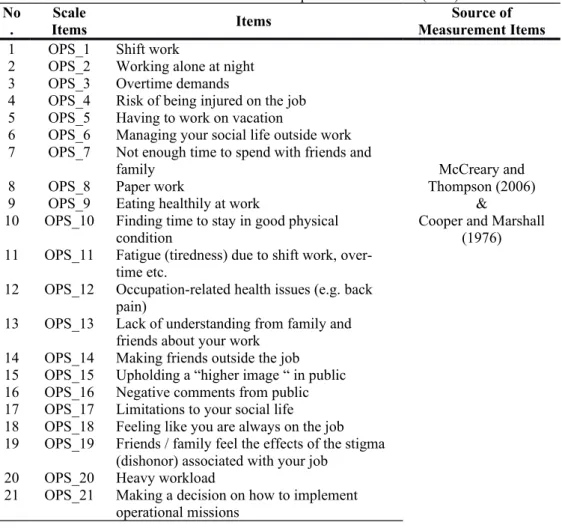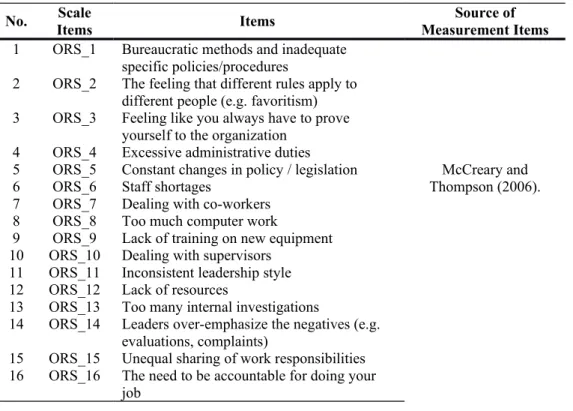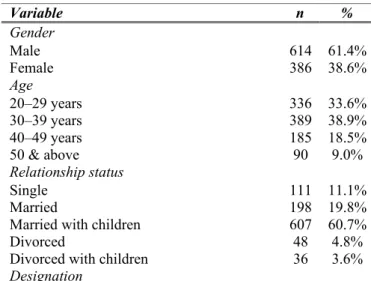The purpose of this research was to identify factors that cause stress in police personnel in the United Arab Emirates and to suggest possible strategies for reducing stress. The survey examined factors that cause stress among police officers in the United Arab Emirates and found operational and organizational stressors. Antecedents of Employee Turnover Intentions in the United Arab Emirates Police Force: A Conceptual Framework.
International Journal of Business and Society (Universiti Malaysia Sarawak). 2018), "Antecedents of turnover intention among police persons in the United Arab Emirates", Academy of Management Proceedings, Vol. Avraam Papastathopoulos for his advice, which proved to be of crucial importance to the development of my thesis.
Introduction
General Background
All occupations are associated with some level of occupational stress, but police officers are likely to be more exposed than many (see Anshel, 2000; previous research on policing suggests that the nature of policing means that police officers are likely to experience very high levels of occupational stress. stress (Alexopoulos, . Palatsidi, Tigani & Darviri, 2014; Brooks, 2017; Shane, 2013; Violanti, Charles, McCanlies, Hartley, Baughman, Andrew, Fekedulegn, Ma, Mnatsakanova & Burchfiel, 2017; V10 Mäulkorensäi, 2017; Police officers have a key role in protecting society and are therefore likely to experience high levels of stress (Brooks, 2017).
The number of injuries and deaths among police officers is higher than in any other profession (Bureau of Labor Statistics, 2011). Operational stressors are those related to police work, while organizational stressors are related to the nature of the organization in which police officers work (Symonds, 1970).
Country Profile: UAE
The next section of this chapter discusses the UAE as a study environment, and in particular its police force. Overall, 91% of respondents found the general safety and security in the UAE to be exemplary (Maceda, 2017). The World Bank Doing Business report recognized the United Arab Emirates as the most welcoming of all Arab countries for start-ups (The World Bank Group, 2019).
This has increased the responsibilities of the police force to ensure the safety and security of the community, especially with the government's aim to place the UAE at the forefront of countries with the. The next section discusses the UAE Police Force, providing information on the number of employees, the organizational structure and the role of the organization in providing safety and security for UAE citizens.
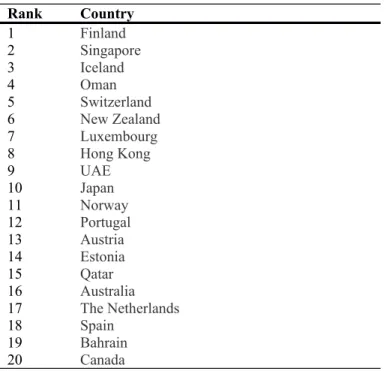
UAE Police
The police sector is considered one of the most critical in the UAE (US Embassies, 2018). The police force employs 17,291 people, or 30.5% of the total number of employees in federal agencies (Abdelhamid, 2015). These include patrols of designated geographic locations from police stations, investigations by detectives from the Crime Investigation Department, and enforcement of traffic laws by the Department of Traffic and Permits. The National Agenda supports the UAE's vision and aims for the UAE to maintain and enhance safety and security in the country by 2021 (UAE Cabinet Ministry, 2019).
The UAE was the highest of the Arab countries and fifth in the world for. This index shows the competence of the police force in the UAE, and explains why it has earned the country a reputation as one of the safest provinces in the world (Schwab, 2018).
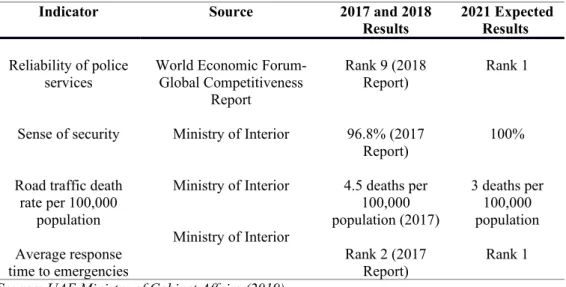
Research Gap and Problem Statement
The person-environment-employment model described how the mismatch between personality traits, work environment and occupational characteristics can lead to work-related stress. To the researcher's knowledge, no studies have used the person-environment-employment (PEO) model to understand work-related stressors in the police. Doing so was therefore considered appropriate to address both the person's level and the work environment and also acknowledges work-related stressors related to occupational characteristics in the police.
As far as can be ascertained, no study in the United Arab Emirates has addressed job stress factors in the police. To fill this gap, this research used the person-environment-occupation (PEO) model and quantitative methodology with multiple methods to develop a more detailed understanding of job stress in the sector responsible for homeland security and safety.
Research Objectives
Only two studies have examined psychological stress in the UAE police (Alhashmi, Jabeen, Al-Nasser, & Papastathopoulos, 2017; Alhashmi, Jabeen, & Papastathopoulos, 2019). The research aimed to determine whether police personnel in the UAE suffer from occupational stress, and if so, what causes they perceive for this stress. It therefore contributes to the understanding of occupational stress in the police profession and in particular why occupational stress is becoming a problem among police officers in the UAE, a country with one of the lowest crime rates in the world.
The study also aimed to determine whether occupational stress among UAE police officers varied with socio-demographic variables, and to establish an associative model to link stressors by examining the interrelationships between the factors affecting both operational and cause organizational stress. Finally, it aimed to develop a decision model to help the organization understand the degree of influence of each factor on police stress and to make suggestions for managing and minimizing stress at work.
Research Questions
H1b: There is a significant difference in the level of operational stress (physical condition, job demands and pressures, and social life and image) between police personnel based on their age group. H1c: There is a significant difference in the level of operational stress (physical fitness, job demands and pressures, and social life and image) among police officers based on their relationship status. H1d: There is a significant difference in the level of operational stress (physical fitness, job demands and pressure, and social life and image) among police personnel based on their level of education.
H1e: There is a significant difference in the level of operational stress (physical condition, job demands and pressures and social life and image) among police personnel based on their level of designation. H2b: There is a significant difference in the level of organizational stress (ineffective leadership and role conflict, and work environment) among police personnel based on their age group.
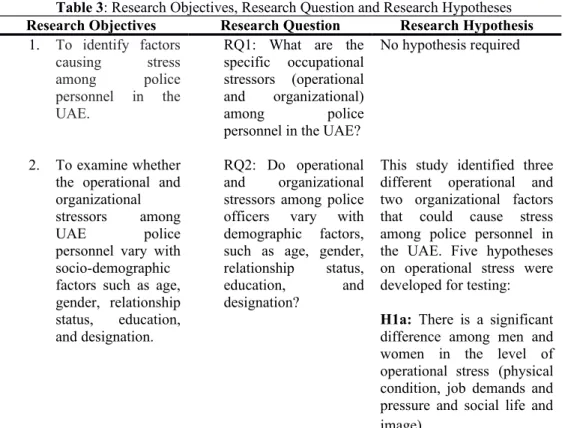
Contribution to Knowledge
The study also used a questionnaire instrument developed by McCreary and Thompson (2006) with a large sample, to examine operational and organizational stressors within the UAE police force. As far as can be ascertained, no previous study has applied all three research strategies (survey, ISM and ANP) to this topic, or used MANOVA and the particular multivariate post-hoc technique chosen for this study (discriminant analysis descriptive or DDA) to explore stress. Furthermore, no studies were found that considered the contextual relationships between stress-related variables, or the use of a multi-criteria model to prioritize stress management strategies.
This study used ISM to develop a relationship model of the causes of stress and their contextual relationships for the UAE Police. It also applied an ANP approach as a multi-criteria decision model to prioritize organizational stress reduction strategies.
Thesis Structure
It goes on to identify the research gap, research objectives and research questions before explaining the importance of this research. Stress theories are also discussed, along with an overview of organizational stress reduction strategies and the most important organizational criteria to consider when selecting stress reduction and coping mechanisms. The chapter explains how the survey findings helped identify stressors among different groups of police personnel, including by age, designation, gender, rank, level of education and years of experience.
This chapter explains the ISM analysis strategy and discusses the results before providing a structural model of the operational and organizational stressors of the UAE Police, categorized by dependency and driving force. It identifies organizational criteria for selecting stress reduction strategies and then prioritizes stress reduction strategies based on these criteria.
Research Process
Conclusion
Literature Review
Overview of Occupational Stress among Police Personnel
- Operational Stressors (OPS)
- Organizational Stressors (ORS)
Stress and its Influence on Demographics
- Operational Stressors and Demographic Variables
- Organizational Stressors and Demographic Variables
Organizational Stress Reduction Strategies
- Social Support Strategy
- Problem-Solving Strategy
- Human Resource Strategies
- Environmental Strategies
Organizational Criteria to Consider for Strategy Selection
- Effectiveness
- Integration
- Cost
- Time
Stress Related Theories
Conclusion
Empirical Study
Research Philosophy
Research Methodology
Research Design
Ethical Considerations
Measurement Instrument Development
Pilot Test
Data Collection and Demographics
Survey Analysis Strategy
Results
Discussion: Empirical Study
Conclusion
Interpretive Structural Modeling (ISM) of Operational and
Interpretive Structural Modeling (ISM)
ISM Analysis Strategy
Results
Discussion: ISM
Conclusion
Prioritizing Stress Management Strategies: An Analytic
Analytic Network Process (ANP)
ANP Analysis Strategy
Results
Discussion: ANP
Conclusion
Conclusion, Implications, Limitations and Scope for
Research Summary
This study developed four main objectives based on a detailed literature review and taking into account the importance of improving health outcomes in the UAE police force. These objectives were to investigate causes of stress and stress reduction strategies among UAE police personnel, to examine whether operational and organizational stressors among UAE police personnel varied with socio-demographic factors such as age, gender, relationship status, education and qualification, a develop a relationship model between stress-causing variables and identify the most effective strategies to reduce operational and organizational stressors, promote better health outcomes and improve productivity. The study used three main methods (survey, ISM and ANP) to achieve these goals and answer all research questions.
Factors such as social life image, job demands and work pressure, and physical conditions in the work environment were all highly relevant operational stress factors that contributed to high stress among police personnel in the UAE. Factors such as ineffective leadership, role conflict and the work environment were considered to be the key organizational stressors that contributed to high stress among police personnel in the UAE. Demographic variations played an important role in influencing how police personnel experienced and coped with stress.
However, there were no age differences for operational or organizational stressors, and there were no differences between managerial, supervisory and technical police personnel in the importance of various operational stressors. Interpretative Structural Modeling showed that UAE police personnel considered heavy workload, lack of autonomy and maintaining a certain social or public image to be drivers of operational stress. The Analytic Network Process Model suggested that a social support strategy would be the most effective strategy for reducing stress.
Social support strategies should therefore be prioritized, but police organizations must consider several factors before adopting new stress reduction strategies. Application of the ANP model provided the opportunity to consider several criteria and sub-criteria simultaneously and choose the best stress reduction strategies.
Implications
- Theoretical Implications
- Practical Implications
Finally, this study contributed to the literature by integrating the existing selection model for stress reduction strategies and the NP approaches, providing a comprehensive and multidimensional view of stress and its management. The modeling technique has made it possible to identify the most appropriate strategy to reduce operational and organizational stress, by simultaneously taking into account interdependencies and feedback between stress variables. This study therefore contributed to the literature and academic research by bringing together new methods and insights into the interrelationships between different stress reduction strategies.
The findings also have other significant implications for organizational policy makers, including top and middle management. First, the study enabled policy makers and others to understand the key factors that cause stress among police officers. This will help police administrators in the Middle East in general and the UAE in particular to change policies and introduce systems to minimize these stressors, which will ultimately improve the performance of police forces.
Second, the study found that age did not significantly affect organizational or operational stressors among police personnel or their ability to manage stress. Third, ISM's findings will help policymakers focus on reducing workplace stress levels. In order to eliminate the negative consequences of stress among police personnel, it is first necessary to identify operational and organizational stressors and understand the relationships between them.
Therefore, these research results will help police forces, policy makers and corporate strategists to formulate stress management strategies, based on findings about operational and organizational stressors that had a significant impact on other stressors, and therefore should be treated first. Finally, the UAE police force should choose and implement an appropriate strategy to reduce stress levels among police personnel. The ANP technique used in this study will help decision makers and policy makers to prioritize strategy choices and can be used for other strategic decisions in the future.
Limitations
Recommendations for Future Research
